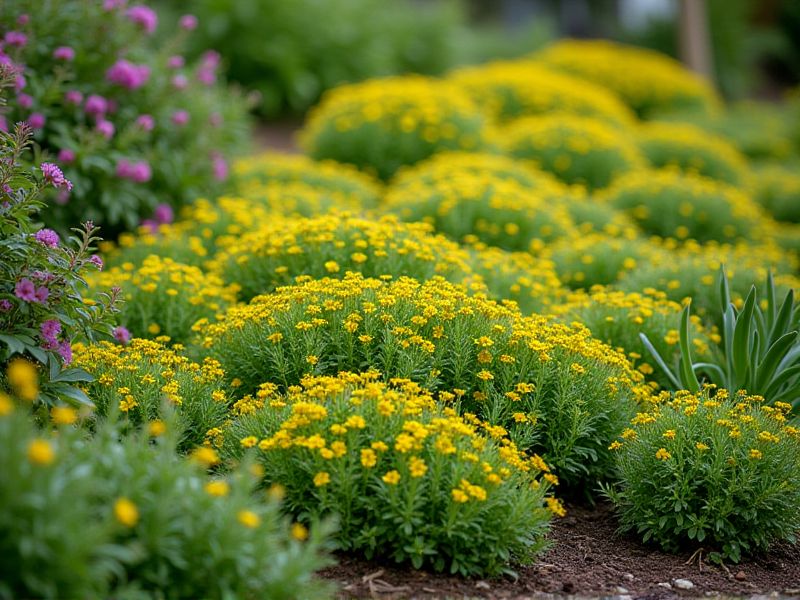
Drought-resistant ground cover plants are essential for low-maintenance landscaping and conserving water. Varieties such as Sedum, also known as stonecrop, thrive in arid conditions and require minimal watering while providing vibrant color. Another excellent choice is Creeping Thyme, which not only withstands dry spells but also produces tiny, fragrant flowers that attract pollinators. For more substantial coverage, consider Juniper ground covers, which offer durability and vibrant foliage throughout the seasons. These plants not only enhance the aesthetic appeal of your garden but also contribute to sustainability by reducing the need for irrigation.
List of some Ground cover plants that are drought-resistant
- Creeping Thyme (Thymus serpyllum)
- Yellow Stonecrop (Sedum acre)
- Lamb's Ear (Stachys byzantina)
- Ice Plant (Delosperma cooperi)
- Blue Star Creeper (Isotoma fluviatilis)
- Hens and Chicks (Sempervivum tectorum)
- Woolly Yarrow (Achillea tomentosa)
- Silver Carpet (Dymondia margaretae)
- Bearberry (Arctostaphylos uva-ursi)
- Pussytoes (Antennaria dioica)
Important things about Ground cover plants that are drought-resistant
Low Water Requirements
Ground cover plants that are drought-resistant thrive in dry conditions, making them perfect for water-efficient landscaping. Varieties such as sedum, creeping thyme, and yarrow not only require minimal irrigation but also reduce soil erosion and enhance garden aesthetics. These hardy plants often feature deep root systems that access moisture from deeper soil layers, ensuring resilience during hot, dry spells. By choosing drought-tolerant ground covers, you can create a lush, sustainable landscape while conserving water and reducing maintenance efforts.
Soil Stabilization
Ground cover plants that are drought-resistant effectively enhance soil stabilization and reduce erosion by establishing a protective layer over the soil. Varieties such as creeping thyme, sedum, and red fescue not only thrive in low-water conditions but also improve soil health by preventing runoff and promoting moisture retention. Their extensive root systems anchor the soil, making them ideal for slopes and areas prone to erosion. Choosing these resilient plants for your landscape can create an environmentally sustainable approach to managing soil integrity while adding beauty to your outdoor spaces.
Erosion Prevention
Ground cover plants play a crucial role in erosion prevention while offering drought-resistance benefits. These low-growing plants, such as sedums, creeping thyme, and clover, establish a dense root system that stabilizes soil and reduces runoff. Their ability to thrive in arid conditions makes them ideal for areas with limited water availability, helping maintain soil integrity even during dry spells. By incorporating these hardy species into your landscape, you can effectively combat soil erosion and promote sustainable gardening practices.
Weed Suppression
Ground cover plants that are drought-resistant serve as effective natural weed suppressors while enhancing landscape aesthetics. Varieties such as creeping thyme and sedum not only thrive in arid conditions but also create dense mats that inhibit weed growth. These resilient plants require minimal irrigation, making them ideal for sustainable gardening and xeriscaping. Incorporating drought-resistant ground cover can significantly reduce maintenance efforts and promote a healthier soil ecosystem by minimizing erosion and enhancing moisture retention.
Aesthetic Appeal
Drought-resistant ground cover plants, such as Sedum, Thymus, and Creeping Phlox, offer both aesthetic charm and practical benefits for your landscape. These low-maintenance plants thrive in arid conditions while providing vibrant colors and unique textures that enhance the visual appeal of gardens and pathways. With their ability to create a lush, green carpet and suppress weeds, these ground covers help maintain soil moisture and reduce the need for frequent watering. Incorporating such resilient species not only conserves water but also contributes to a stunning outdoor environment year-round.
Variety Of Species
Ground cover plants such as Sedum, Thyme, and creeping Juniper thrive in arid conditions, making them ideal for drought-resistant landscaping. These hardy species not only require minimal water but also help prevent soil erosion and suppress weeds, creating a sustainable environment in your garden. Succulent varieties, like Ice Plant, are particularly effective due to their ability to store moisture, ensuring vibrant foliage even during dry spells. Incorporating these drought-resistant ground covers can enhance your landscape's aesthetic while promoting ecological balance and reducing water usage.
Adaptability To Different Soils
Ground cover plants that are drought-resistant excel in various soil types, from sandy to clay-heavy compositions. These resilient species, such as Sedum and Creeping Thyme, thrive with minimal moisture, making them ideal for xeriscaping. Their extensive root systems allow them to stabilize soil, prevent erosion, and improve water retention, benefiting the surrounding ecosystem. By integrating these adaptive ground covers into your garden, you enhance biodiversity while reducing the need for frequent irrigation.
Wildlife Habitat Support
Ground cover plants play a crucial role in supporting wildlife habitats by providing essential shelter and food resources. Drought-resistant species, such as creeping thyme, sedum, and lantana, thrive in arid conditions while maintaining soil stability and reducing erosion. These hardy plants attract pollinators like bees and butterflies, fostering biodiversity within your garden. By incorporating drought-tolerant ground covers, you create a sustainable environment that benefits both local fauna and your landscape's aesthetic appeal.
Minimal Maintenance Needs
Ground cover plants that are drought-resistant are ideal for low-maintenance landscaping, providing lush, sprawling coverage while conserving water. Varieties such as creeping thyme, sedum, and certain types of succulents excel in arid conditions, thriving with minimal care. These hardy plants not only reduce the need for frequent watering but also suppress weeds and enhance soil stability. Incorporating drought-resistant ground covers into your garden design can create an attractive landscape that is both eco-friendly and cost-efficient.
Seasonal Interest
Ground cover plants that are drought-resistant offer a sustainable solution for your landscaping needs. Varieties such as succulents, such as Sedum and Sempervivum, thrive in arid conditions while providing vibrant color and texture. Other excellent options include creeping thyme and stonecrop, which not only enhance soil stability but also require minimal irrigation. Incorporating these resilient plants into your garden can reduce water usage, promote biodiversity, and create an attractive, low-maintenance outdoor space.
